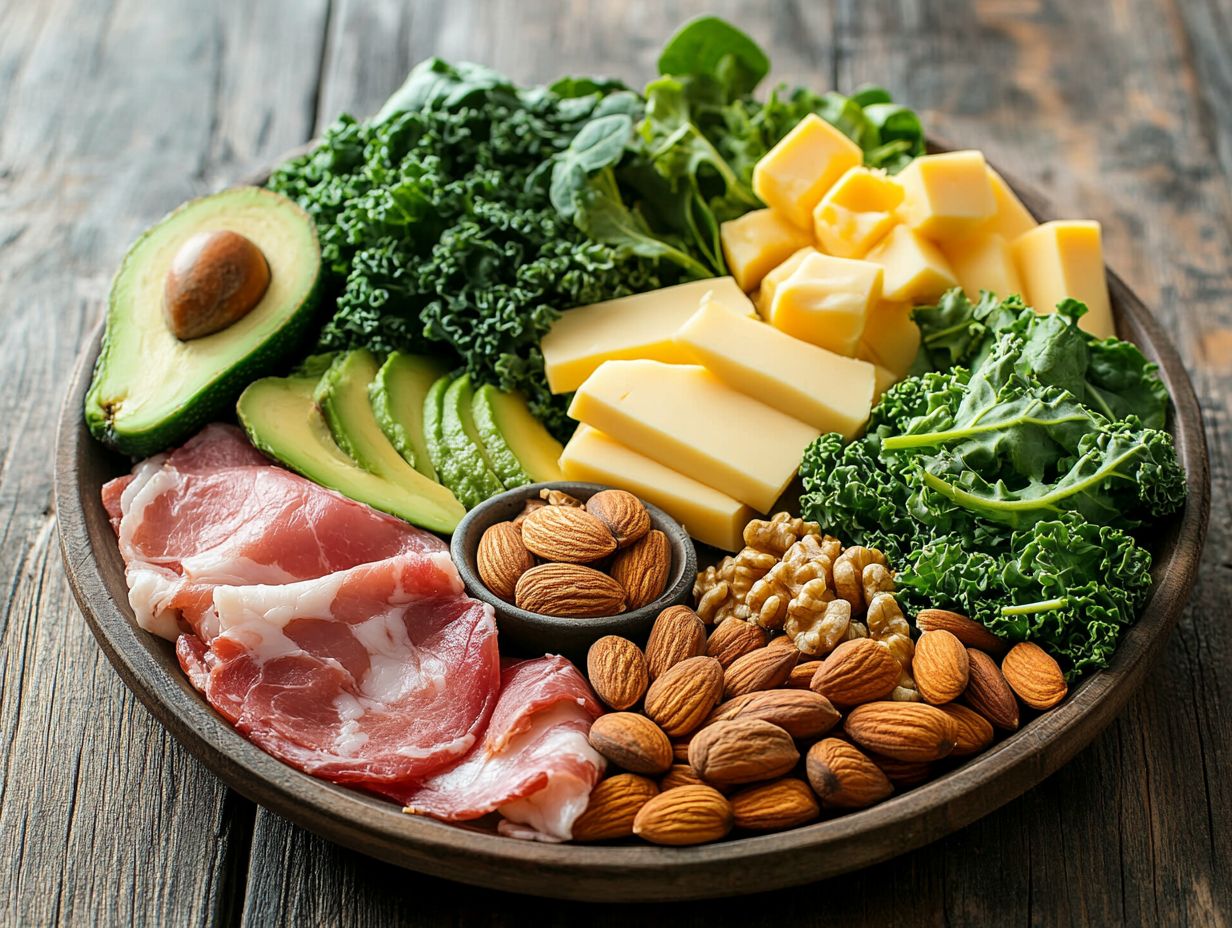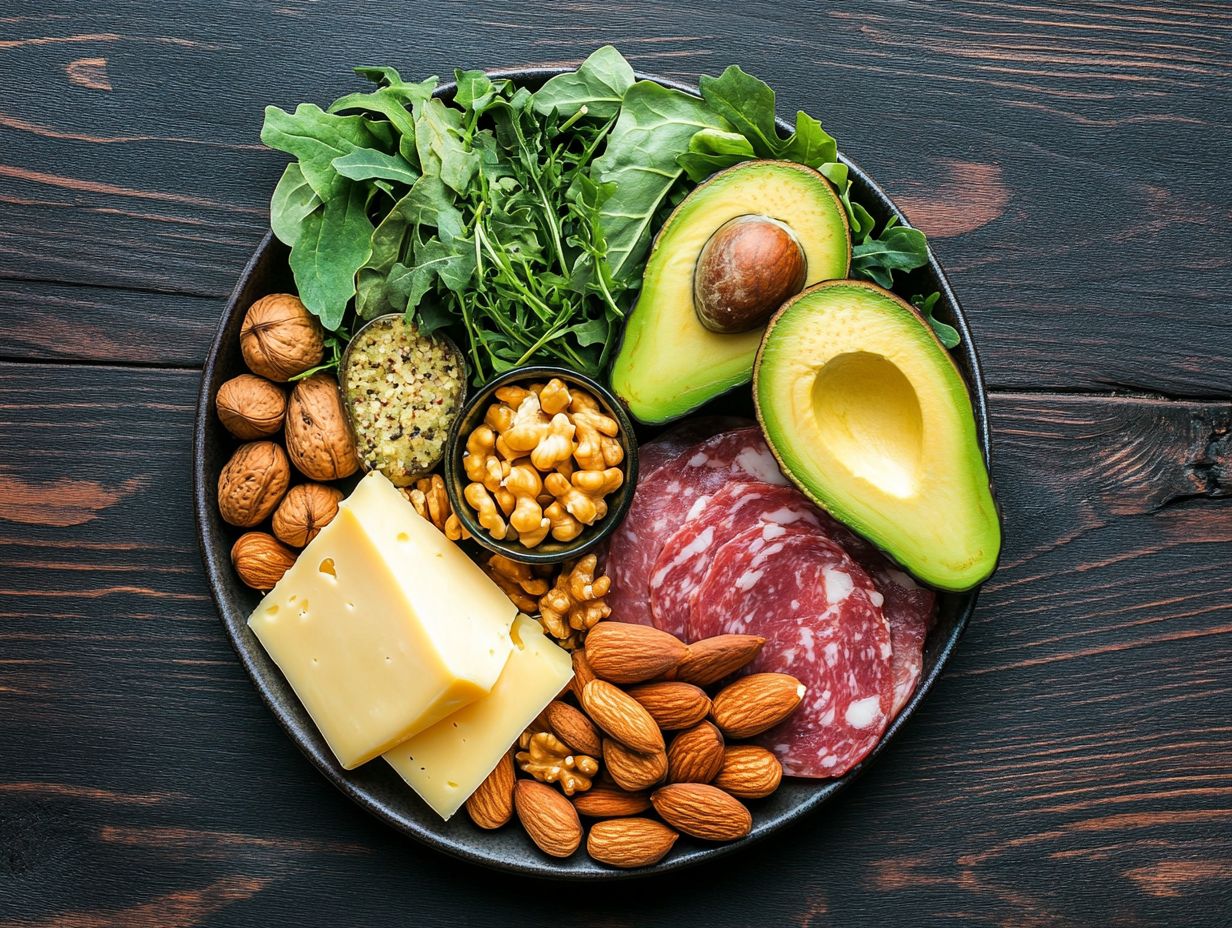Keto Diet: Understanding Macronutrient Ratios
Contents
- Understanding the Keto Diet: Macronutrient Ratios Explained
- Key Takeaways:
- What are the Recommended Macronutrient Ratios for the Keto Diet?
- What is the Cyclical Keto Diet Ratio?
- What is the Targeted Keto Diet Ratio?
- How to Calculate and Track Your Macronutrient Ratios for the Keto Diet?
- What are the Best Tools for Tracking Macronutrient Ratios?
- What are the Common Mistakes to Avoid When Calculating and Tracking Macronutrient Ratios?
- What are the Benefits of Following the Right Macronutrient Ratios on the Keto Diet?
- Understanding the Ketogenic Diet
- What are the Potential Risks and Side Effects of the Keto Diet?
- Consulting with a Healthcare Professional Before Starting the Keto Diet
- Frequently Asked Questions about the Keto Diet
- What is the Keto Diet and why is understanding macronutrient ratios important?
- What are the ideal macronutrient ratios for optimal fat intake on a Keto Diet?
- How do I calculate my macronutrient ratios and manage my calorie intake on a Keto Diet?
- Can I adjust my macronutrient ratios on a Keto Diet to suit my dietary needs?
- What happens if I don’t follow the recommended macronutrient ratios on a restrictive diet like Keto?
- How can I track my macronutrient ratios on a Keto Diet to ensure sustainable health?
Understanding the Keto Diet: Macronutrient Ratios Explained
The keto diet has surged in popularity, offering the promise of effective weight loss and enhanced mental clarity. To truly reap these benefits, it’s crucial for you to grasp the right macronutrient ratios, which involve balancing your fat intake, protein intake, and carb intake.
Get ready to explore the exciting world of keto diet ratios that can transform your health journey! In this article, you’ll delve into various keto diet ratios, including standard, high-protein, cyclical, and targeted approaches. You’ll gain insights on how to accurately calculate and track your macronutrient intake, understand the benefits of sticking to these ratios, recognize potential risks, and appreciate the importance of consulting a healthcare professional or registered dietitian before embarking on this journey.
Join in as you navigate the essentials of keto macronutrient management to achieve optimal health, keeping in mind the dietary guidelines and modifications that may be necessary based on your health conditions.
Key Takeaways:

- Following the recommended macronutrient ratios is crucial for success on the keto diet to avoid nutritional deficiencies and promote sustainable health.
- Tracking macronutrient ratios accurately and avoiding common mistakes can help achieve and maintain ketosis, preventing insulin resistance and other metabolic issues.
- The right macronutrient ratios can lead to benefits such as improved energy levels, weight loss, and reduced hunger and cravings, contributing to effective appetite suppression.
What are the Recommended Macronutrient Ratios for the Keto Diet?
The recommended macronutrient ratios for the keto diet are carefully crafted to help you enter a state of ketosis, where your body transitions its primary energy source from carbohydrates to fats. This dietary approach emphasizes a high intake of fats, moderate protein consumption, and a substantial reduction in carbohydrates, all of which can be adjusted based on your unique dietary needs and health conditions, such as metabolic disorders or diabetes.
By grasping these ratios, you can effectively customize your keto macros to achieve your weight loss goals, boost your energy levels, and enhance your overall health while staying true to established dietary guidelines. Health professionals, such as those from the Nutrition Academy or StatPearls, often recommend tracking your macros to ensure you remain compliant and successful with the ketogenic diet.
What is the Standard Keto Diet Ratio?
The standard keto diet ratio generally comprises about 70-75% dietary fats, 20-25% proteins, and a mere 5-10% carbohydrates.
This precise macronutrient distribution is vital, as it propels your body into a metabolic state called ketosis. In this state, your body primarily burns fat for fuel instead of glucose. Achieving and maintaining ketosis can profoundly influence your weight loss journey and overall health, offering benefits like improved mental clarity and consistent energy levels.
Individual needs can vary significantly based on factors such as age, activity level, and existing health conditions. For instance, if you have a metabolic disorder or conditions like obesity or heart disease, you might need a carefully calibrated ratio to manage your symptoms effectively. This highlights the importance of a personalized approach when it comes to dietary planning.
What is the High-protein Keto Diet Ratio?
In a high-protein keto diet, you typically increase your protein intake to about 30% of your total calories, while fats account for around 60-65%, and carbohydrates remain low at 5-10%.
This approach stands in contrast to standard ketogenic diets, which usually boast a higher fat content of about 70-75%. By elevating your protein consumption, the high-protein version may offer distinct advantages, especially if you re focused on managing your weight while preserving lean muscle mass. This makes it a suitable option for those undergoing bariatric surgery or battling conditions like cancer.
This strategy can be particularly beneficial for those engaged in resistance training or aiming to boost their metabolic rate. By incorporating a higher protein intake, you can enhance feelings of fullness, which helps reduce overall calorie consumption without leaving you constantly craving more. It s a compelling choice for those passionate about weight management and combating conditions like metabolic syndrome.
What is the Cyclical Keto Diet Ratio?
The cyclical keto diet ratio invites you to alternate between periods of strict ketosis and higher carb intake. Typically, this diet is structured as five days of keto followed by two days of increased carbohydrates.
This method is designed to promote fat-burning during those initial five days. Afterward, you have the opportunity to load up on carbs to replenish glycogen stores that may have dipped during the stricter phases.
Athletes, in particular, may find this approach advantageous. It allows them to benefit from ketosis for better fat utilization while ensuring they have the energy needed for demanding training sessions. This approach also provides a balanced diet that supports sustainable health.
This pattern cultivates improved metabolic flexibility, enabling your body to transition effortlessly between burning fat and carbohydrates. As a result, adopting this balanced approach can lead to better performance outcomes and elevated overall energy levels, which are crucial for managing chronic conditions like diabetes.
What is the Targeted Keto Diet Ratio?
The targeted keto diet ratio invites you to strategically time your carbohydrate intake around your workouts. It typically recommends 20-30 grams of carbs before exercise to elevate your energy levels.
By adopting this approach, you can enhance your performance without straying from your ketogenic lifestyle. This method is particularly beneficial for those engaged in high-intensity workouts, where quick bursts of energy are crucial.
Consuming carbohydrates prior to exercise provides the necessary fuel without significantly disrupting your state of ketosis. This allows you to balance your energy needs with fat-burning processes.
This targeted intake helps refill your glycogen stores, ensuring you’re ready for peak performance while maintaining your fat-adapted metabolism effectively.
Thus, the targeted keto diet serves as a powerful tool to boost your workout efficacy while supporting your ongoing fat loss objectives. This approach tailors your diet to manage specific health conditions effectively.
How to Calculate and Track Your Macronutrient Ratios for the Keto Diet?

Calculating and tracking your macronutrient ratios on the keto diet is crucial for adhering to dietary guidelines. These guidelines support effective weight loss and optimal health benefits, especially in managing conditions like heart disease.
This process involves determining your daily calorie intake and then allocating specific percentages to fats, proteins, and carbohydrates based on your unique dietary needs and goals. Monitoring your calorie intake helps maintain the calorie deficit necessary for weight loss.
By leveraging various tools and apps designed for macronutrient tracking, you can maintain a well-balanced diet while avoiding potential nutritional deficiencies that often accompany restrictive eating patterns. Try out popular apps like Health.com today to simplify your journey on the keto diet!
What are the Best Tools for Tracking Macronutrient Ratios?
Some of the best tools for tracking macronutrient ratios on the keto diet include popular apps like Carb Manager. This app allows you to log your food intake and easily calculate your keto macros. It can help you follow the dietary recommendations from registered dietitians and healthcare providers.
This app truly stands out with its comprehensive database. It makes it simple for you to find and log various foods, helping you easily track how many carbs, proteins, and fats you eat.
Other noteworthy options in the market, such as MyFitnessPal and Cronometer, offer unique features tailored specifically for keto enthusiasts. These include customizable macro ratios and detailed nutritional insights. These tools help you maintain your keto macros and ensure you’re consuming nutrient-rich foods from various food groups.
You can take advantage of features like barcode scanning for easy entry of packaged goods. There are also meal plans that cater directly to the ketogenic lifestyle. These features promote a balanced diet while allowing for modifications as needed.
The user-friendly interfaces of these tools make them accessible for everyone. Whether you re just starting out or you re a seasoned keto dieter, these tools can help you achieve your nutritional goals with greater ease.
What are the Common Mistakes to Avoid When Calculating and Tracking Macronutrient Ratios?
Common mistakes when calculating and tracking macronutrient ratios for the keto diet often include inaccurate measurement of food portions and miscalculating calorie intake. Neglecting protein consumption is another error that can jeopardize the effectiveness of a high-fat diet and impede your weight management goals.
These oversights can lead to unintended carbohydrate intake or insufficient protein levels. Both can hinder your weight loss efforts and affect your overall health. A frequent pitfall is relying too heavily on estimates instead of using a food scale. This can introduce discrepancies in your daily macro counts, impacting your ability to maintain a calorie deficit.
To avoid these challenges, invest in reliable measuring tools. Familiarize yourself with the nutritional content of various foods.
Utilizing an app to log your meals can significantly enhance your accountability. This ensures that you stay within your target ratios and paves the way for successful adherence to the keto lifestyle.
What are the Benefits of Following the Right Macronutrient Ratios on the Keto Diet?
Adhering to the right macronutrient ratios on the keto diet presents a multitude of advantages. Most notably, it allows you to enter and sustain a state of ketosis, which is essential for optimizing fat burning and facilitating effective weight loss.
This diet can also help manage chronic conditions like cancer and Alzheimer’s disease.
By following these specific ratios, you can regulate your appetite, stabilize your energy levels, and enhance your mental clarity. No wonder the ketogenic diet is a favorite among health enthusiasts seeking to elevate their overall health and efficiently manage their weight. It can also reduce the risks of chronic diseases such as heart disease and obesity.
Health professionals frequently highlight the significance of customized macronutrient ratios and understanding the role of macronutrients to maximize these benefits for each individual.
Understanding the Ketogenic Diet
1. Achieve and Maintain Ketosis
Achieving ketosis is your primary goal on the ketogenic diet. This is where your body transitions from burning carbohydrates to utilizing fats as its main energy source.
This dietary approach is known for its unique balance of nutrients. This metabolic state is defined by elevated levels of ketones in your bloodstream, providing an alternative fuel source for energy-hungry organs, particularly your brain.
To initiate ketosis, you’ll typically need to reduce your carbohydrate intake to about 5-10% of your total daily calories while increasing your fat consumption to approximately 70-80%. Protein intake should remain at a moderate level of around 20%.
As your carbohydrate reserves dwindle, your insulin levels decrease. Insulin is a hormone that helps control blood sugar, and lowering it encourages fat burning. This allows your body to break down stored fat into fatty acids and ketones, signifying a significant physiological transition.
Understanding the delicate balance of these nutrients is essential, as they directly influence your body’s ability to sustain this state over time. Properly tracking your intake can help you maintain ketosis efficiently.
2. Control Hunger and Cravings
One of the key advantages of the keto diet is its remarkable ability to control hunger and suppress cravings. This factor can greatly enhance your weight management journey.
This appetite suppression is one of the diet’s significant health benefits. This impressive effect primarily stems from the high intake of healthy fats and proteins, which are known for promoting feelings of fullness.
Research suggests that indulging in these nutrients stimulates the release of hormones such as glucagon-like peptide-1 (GLP-1) and peptide YY (PYY). Both of these hormones are instrumental in regulating appetite.
As your body transitions into a state of ketosis, it becomes increasingly adept at burning fat for energy, leading to reduced hunger levels. As a result, you may find it significantly easier to resist the allure of snacks and maintain control over your eating habits, ultimately supporting your long-term weight management goals.
3. Improve Energy Levels and Mental Clarity

Improving your energy levels and mental clarity is a significant benefit of embracing the ketogenic diet. Your body becomes adept at utilizing fats for fuel.
When your body transitions into ketosis, it starts to burn fat for energy instead of carbohydrates. This shift leads to a more stable release of energy, enhancing your physical performance and promoting brain health by supplying ketones an exceptionally powerful energy source for your brain.
Research suggests that these ketones can help reduce brain fog, enhance focus, and improve cognitive functions over the long term. By consistently providing your brain cells with a reliable energy supply, you may experience sharper memory retention, quicker information processing, and an increased ability to concentrate.
The ketogenic diet is an exciting choice for anyone looking to boost mental sharpness and vitality!
4. Promote Weight Loss and Fat Burning
The ketogenic diet is renowned for its remarkable ability to promote weight loss and enhance fat burning. This is primarily achieved by creating a calorie deficit through reduced carbohydrate intake.
This restrictive diet’s focus on high fats and low-carb intake is essential for achieving these results. By significantly lowering your carbohydrate consumption, your body is prompted to enter a state of ketosis, where it begins to utilize fat as its primary fuel source instead of glucose.
This pivotal shift in metabolism leads to increased fat oxidation, helping you shed excess pounds while also boosting your energy levels.
The specific ratio of macronutrients high fats, moderate proteins, and very low carbohydrates is crucial in this journey. These ratios directly influence your insulin levels and encourage your body to tap into stored fat for energy.
Understanding these mechanisms enables you to tailor your approach for optimal weight management and improved health.
What are the Potential Risks and Side Effects of the Keto Diet?
While the keto diet can present a multitude of advantages, it s crucial for you to remain mindful of the potential risks and side effects that may emerge as you embark on this journey.
These can include the notorious keto flu, nutritional deficiencies, and various digestive issues. Awareness of these risks is crucial for long-term effects and sustainable health.
1. Keto Flu
Keto flu describes a collection of symptoms you might encounter as your body adjusts to the ketogenic diet think fatigue, headaches, and irritability.
This temporary condition often makes an appearance within the first few days of drastically cutting back on carbohydrates and can linger anywhere from a few days to a week. As your body shifts from using glucose for energy to burning fat, it may experience withdrawal-like symptoms similar to those experienced by people withdrawing from sugar. Alongside fatigue and irritability, you may also notice nausea, dizziness, muscle cramps, and sleep disruptions.
To ease these effects, focus on staying well-hydrated, increasing your salt intake, and ensuring your electrolyte levels are adequate. Taking a gradual approach to these dietary changes and incorporating nutrient-dense foods can facilitate a smoother transition, ultimately enhancing your overall well-being during this phase.
2. Nutrient Deficiencies
Nutrient deficiencies can sneak up on you while following the keto diet if you don t prioritize a balanced intake of nutrient-rich foods, which could lead to health complications. Ensuring a balanced diet that meets all your dietary needs is essential.
This becomes especially crucial considering the significant reduction in carbohydrates, which often limits the variety of foods you typically enjoy. Don’t wait until you feel unwell; ensure you re getting the nutrients your body craves now! To maintain optimal health, it’s essential to incorporate a wide array of nutrient-dense options that supply the vital vitamins and minerals your body craves.
For example, potassium and magnesium are often lacking in many keto meal plans. By including avocados, leafy greens, and nuts, you can effectively replenish these important nutrients. Adding fatty fish helps boost heart health with omega-3 fatty acids and also delivers valuable vitamins D and B12.
By ensuring diversity in your food choices while on a keto regimen, you can significantly reduce the risk of nutrient deficiencies and enhance your overall well-being.
3. Digestive Issues
You might experience digestive issues like constipation and gastrointestinal discomfort as you adjust to the keto diet, often stemming from a low fiber intake due to reduced carbohydrate sources. This drop in dietary fiber typically coincides with the removal of fruits, whole grains, and legumes foods that are traditionally abundant in fiber.
As you transition into ketosis, your body may experience some growing pains, leading to imbalances in gut bacteria and disrupted digestion. To combat these potential issues, consider integrating low-carb, high-fiber foods into your meals, such as:
- Leafy greens
- Avocados
- Chia seeds
Additionally, staying well-hydrated and possibly incorporating electrolyte supplements can further bolster your digestive health while you stick to the keto regimen. Educating yourself about the best food choices on this low-carb journey is crucial for maintaining your gut health and overall well-being.
4. Increased Risk of Kidney Stones

The ketogenic diet may elevate the risk of kidney stones for some individuals, especially if you don’t maintain adequate hydration levels. This dietary approach, which emphasizes high fat and very low carbohydrate intake, can lead to increased excretion of calcium and oxalate in your urine two key players in the formation of kidney stones. The significant reduction in carbohydrates often pushes your body into a unique metabolic state known as ketosis, altering how you process certain nutrients.
To lower the risk of kidney stones while embracing a keto lifestyle, it’s essential for you to prioritize hydration by drinking ample fluids throughout the day. Additionally, incorporating foods that are lower in oxalate, such as specific meats and dairy products, while ensuring you get enough magnesium and potassium, can help you maintain a balanced mineral profile and support your renal health.
Consulting with a Healthcare Professional Before Starting the Keto Diet
Consulting with a healthcare professional, such as a registered dietitian, before starting the keto diet is essential, particularly if you have pre-existing health conditions like diabetes, obesity, or metabolic syndrome. This consultation helps align the diet with your specific dietary needs and ensures you follow the appropriate dietary guidelines.
This initial consultation serves several important purposes. Your healthcare professional can conduct a comprehensive assessment of your medical history and current health status, ensuring that the carbohydrate restrictions inherent to the keto lifestyle are suitable for your specific health needs. They can also assist you in creating a well-balanced meal plan that diversifies your nutrient intake while adhering to ketogenic principles.
By monitoring your progress and making necessary adjustments, healthcare professionals can support healthier weight loss and offer guidance on managing potential side effects, such as the keto flu or nutritional deficiencies. This personalized support is crucial for achieving long-term success and optimizing your overall well-being throughout your ketogenic diet journey.
Frequently Asked Questions about the Keto Diet
What is the Keto Diet and why is understanding macronutrient ratios important?
The Keto Diet is a high-fat, moderate-protein, and very low-carb diet that forces the body to burn fat for energy instead of carbohydrates. Understanding macronutrient ratios is critical because it helps you achieve and maintain a state of ketosis, where your body primarily burns fat for fuel. Proper macronutrient ratios also help manage health conditions like diabetes and metabolic syndrome.
What are the ideal macronutrient ratios for optimal fat intake on a Keto Diet?
The ideal macronutrient ratios for a Keto Diet are typically 70-80% fat, 20-25% protein, and 5-10% carbohydrates. These ratios may vary slightly based on individual factors such as activity level, body composition, and personal goals. Monitoring your carb intake is essential to maintaining ketosis.
How do I calculate my macronutrient ratios and manage my calorie intake on a Keto Diet?
To calculate your macronutrient ratios for a Keto Diet, first, determine your daily calorie intake and then allocate those calories based on the percentages mentioned above. Numerous online calculators and resources, such as Carb Manager, are available to assist you with this process.
Can I adjust my macronutrient ratios on a Keto Diet to suit my dietary needs?
Yes, you can adjust your macronutrient ratios on a Keto Diet based on your individual dietary needs and goals. For instance, if you want to build muscle, you may need to increase your protein intake slightly. Listening to your body and making adjustments as needed is essential. Consulting a registered dietitian can also be beneficial.
What happens if I don’t follow the recommended macronutrient ratios on a restrictive diet like Keto?
If you don’t follow the recommended macronutrient ratios on a Keto Diet, you may struggle to achieve or maintain a state of ketosis. This could prevent you from experiencing the full benefits of the diet, such as weight loss and improved energy levels. Sticking to the recommended ratios is vital for achieving the best results and avoiding potential health risks.
How can I track my macronutrient ratios on a Keto Diet to ensure sustainable health?
There are several ways to track your macronutrient ratios on a Keto Diet, including using a food tracking app like Carb Manager, keeping a food journal, or working with a registered dietitian. Tracking your intake is important to ensure you meet your recommended ratios and stay on track with your goals. This practice can also help manage appetite suppression and ensure adherence to dietary recommendations.
If you are considering starting the keto diet, consult with your healthcare professional to explore further resources on managing your dietary needs effectively.






